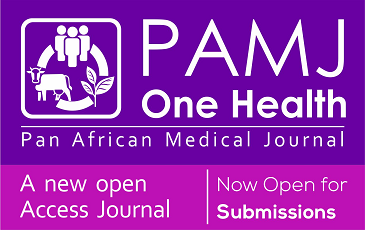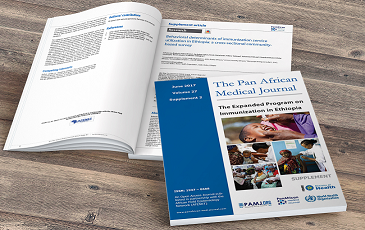Early prenatal diagnosis of a severe thoraco-abdominal wall defect with a short umbilical cord: a case report
Ghada Abdelmoula, Houssem Ragmoun, Montacer Hafsi, Asma Zouaghi, Azer Hafsi, Eya Kristou, Sarra Rihani
Corresponding author: Ghada Abdelmoula, Regional Hospital of Menzel Temime, Department of Gynecology and Obstetrics, 8080, Menzel Temime, Nabeul, Tunisia 
Received: 12 Apr 2025 - Accepted: 06 Jul 2025 - Published: 29 Jul 2025
Domain: Gynecology, Obstetrics and gynecology
Keywords: Umbilical cord abnormalities, early diagnosis, ultrasonography, prenatal, case report
Funding: This work received no specific grant from any funding agency in the public, commercial, or not-for-profit sectors.
©Ghada Abdelmoula et al. PAMJ Clinical Medicine (ISSN: 2707-2797). This is an Open Access article distributed under the terms of the Creative Commons Attribution International 4.0 License (https://creativecommons.org/licenses/by/4.0/), which permits unrestricted use, distribution, and reproduction in any medium, provided the original work is properly cited.
Cite this article: Ghada Abdelmoula et al. Early prenatal diagnosis of a severe thoraco-abdominal wall defect with a short umbilical cord: a case report. PAMJ Clinical Medicine. 2025;18:11. [doi: 10.11604/pamj-cm.2025.18.11.47581]
Available online at: https://www.clinical-medicine.panafrican-med-journal.com//content/article/18/11/full
Case report 
Early prenatal diagnosis of a severe thoraco-abdominal wall defect with a short umbilical cord: a case report
Early prenatal diagnosis of a severe thoraco-abdominal wall defect with a short umbilical cord: a case report
![]() Ghada Abdelmoula1,2,&, Houssem Ragmoun1,2,
Ghada Abdelmoula1,2,&, Houssem Ragmoun1,2, ![]() Montacer Hafsi1, Asma Zouaghi1,
Montacer Hafsi1, Asma Zouaghi1, ![]() Azer Hafsi1, Eya Kristou1,
Azer Hafsi1, Eya Kristou1, ![]() Sarra Rihani1
Sarra Rihani1
&Corresponding author
A short umbilical cord, defined as less than 35 cm at term, is a rare anomaly associated with adverse obstetric outcomes. We report a case in which this condition was identified as early as 12 weeks of gestation through routine transabdominal ultrasound and 3D imaging. A 29-year-old gravida 2 para 1 woman presented for first-trimester screening, which revealed an umbilical cord measuring only 8 cm and a severe thoraco-abdominal wall defect with exteriorization of the liver, intestines, and heart. Despite these anomalies, Doppler studies showed normal umbilical artery flow. After multidisciplinary counseling, the pregnancy was terminated at 12 weeks. Fetopathologic examination confirmed the wall defect and evisceration of abdominal and thoracic organs, with normal placental morphology. This case highlights the critical role of early prenatal imaging in detecting complex fetal anomalies and underscores the value of integrating advanced ultrasound techniques into routine first-trimester screening to support timely diagnosis and individualized care.
The umbilical cord plays a crucial role in fetal development by facilitating nutrient and oxygen exchange while eliminating waste. Deviations from its normal length, particularly a short umbilical cord-defined as less than 35 cm at term-have been associated with restricted fetal movement, intrauterine growth restriction (IUGR), preterm birth, and adverse perinatal outcomes [1]. These anomalies are most often diagnosed later in pregnancy, during delivery, or postnatal [1]. Early prenatal diagnosis could allow for closer surveillance and individualized management to reduce potential complications [2]. We report a case of a short umbilical cord identified in the first trimester, associated with a severe thoraco-abdominal wall defect.
Patient information: a 29-year-old gravida 2, para 1 woman presented for routine prenatal care at 12 weeks of gestation, with no specific complaints or symptoms at the time of consultation. She was asymptomatic and the visit was part of standard first-trimester screening. Her medical history was unremarkable, with no prior chronic illnesses, surgeries, or obstetric complications in her previous pregnancy, which resulted in a term vaginal delivery without notable issues. There was no known family history of congenital anomalies, genetic disorders, or hereditary diseases. Psychosocial assessment revealed stable living conditions, no exposure to teratogens or harmful environmental factors, and no history of substance use or significant stressors during pregnancy. No previous interventions related to her current pregnancy were reported, and she had not undergone any invasive prenatal diagnostic procedures before this visit.
Timeline of current episode: at 12 weeks of gestation, routine prenatal ultrasound revealed a significantly short umbilical cord. Further imaging and Doppler studies confirmed the finding. After multidisciplinary counseling, pregnancy termination was performed at 12 weeks and 3 days. Post-procedure fetopathologic examination confirmed the ultrasound findings, with an umbilical cord length of 8 cm, normal placental morphology, and no additional fetal anomalies.
Clinical findings: transabdominal ultrasound performed at 12 weeks of gestation reveals a severe thoraco-abdominal wall defect with the heart located outside the thoracic cavity (ectopia cordis). The umbilical cord is notably shortened, measuring approximately 8 cm (red arrow) (Figure 1). Despite these anomalies, amniotic fluid volume and fetal movements were within normal limits. No other malformations were detected.
Diagnostic assessment: high-resolution ultrasound and 3D imaging were used to assess fetal morphology and umbilical cord length. The diagnosis of a short umbilical cord associated with a severe thoraco-abdominal wall defect was established. Doppler evaluation revealed preserved umbilical artery flow. The combination of findings, although rare and complex, was carefully differentiated from other congenital malformations through expert review.
Diagnosis: a diagnosis of isolated short umbilical cord (8 cm) associated with a thoraco-abdominal wall defect was made at 12 weeks, confirmed both by imaging and fetopathologic examination. Due to the poor prognosis, the decision was made to terminate the pregnancy.
Therapeutic interventions: after comprehensive multidisciplinary counseling, medical termination of pregnancy was performed at 12 weeks of gestation, in accordance with established protocols prioritizing maternal safety.
Follow-up and outcome of interventions: post-termination fetopathologic examination (Figure 2) demonstrates a major defect of the thoraco-abdominal wall with exteriorization of the heart, liver, and intestines. The umbilical cord is shortened to 8 cm (red arrow), consistent with prenatal imaging. Placental morphology appears normal. These findings confirm the prenatal diagnosis of the severe congenital anomaly. The patient had an uneventful recovery and was offered post-termination counseling for future pregnancies.
Patient perspective: the patient reported a clear understanding of the anomaly and its implications. She expressed appreciation for the clarity and compassion of the counseling received and stated that the support provided helped her make an informed and confident decision.
Informed consent: written informed consent was obtained from the patient for publication of this case report, including the use of anonymized clinical data and images, in accordance with institutional and ethical guidelines.
The early detection of congenital anomalies during the first trimester has significant implications for clinical decision-making, parental counseling, and perinatal outcomes. In this case, a severe thoraco-abdominal wall defect and an abnormally short umbilical cord were identified at 12 weeks of gestation through high-resolution ultrasonography. The umbilical cord plays a vital role in fetal development, and deviations in its length-particularly a short cord, defined as 35 cm at term-have been associated with intrauterine growth restriction, fetal distress, and adverse outcomes [3]. The etiology of a short umbilical cord remains unclear but is likely multifactorial, involving reduced fetal movements, intrinsic developmental anomalies of the cord, and uterine constraints.
Ectopia cordis, observed in this case, is a rare congenital anomaly characterized by partial or complete extrusion of the heart from the thoracic cavity, with a prevalence estimated at 5-8 per million live births. It is most commonly classified as thoracic (60%) but may also present as cervical, thoracoabdominal, or abdominal variants [4]. When ectopia cordis occurs in association with other midline defects such as sternal cleft, diaphragmatic hernia, and omphalocele, the constellation of findings is consistent with Pentalogy of Cantrell. This syndrome results from defective migration or fusion of mesodermal folds during embryogenesis and is associated with high perinatal mortality. Its estimated prevalence ranges from 1 in 65,000 to 1 in 200,000 live births [4].
The prenatal identification of thoraco-abdominal wall defects necessitates careful consideration of differential diagnoses. In early gestation, physiological midgut herniation may obscure accurate diagnosis, but persistence or severe extrusion of organs into the amniotic cavity raises suspicion for omphalocele, gastroschisis, body stalk anomaly, or complex syndromes such as pentalogy of Cantrell [5]. Accurate differentiation relies on detailed imaging and characterization of associated anomalies, including the presence or absence of a membrane, liver herniation, cardiac displacement, and umbilical cord insertion. In this case, the absence of a covering membrane and the evisceration of thoracic and abdominal organs were suggestive of a severe midline defect, distinct from isolated omphalocele or gastroschisis.
The prognosis for fetuses with pentalogy of Cantrell is poor, with survival largely dependent on the severity of cardiac anomalies and the degree of extracorporeal organ involvement. Surgical correction may be attempted postnatally in select cases, but survival rates remain low, around 37% in some series [6]. In contrast, isolated gastroschisis generally carries a better prognosis, although liver herniation is an unfavorable prognostic factor. Management of such complex anomalies requires a multidisciplinary approach involving maternal-fetal medicine, pediatric surgery, neonatology, and cardiology. Delivery in tertiary centers with neonatal intensive care units and pediatric surgical teams is essential for optimizing outcomes [6].
In this case, early ultrasonographic diagnosis enabled timely multidisciplinary counseling. Given the severity and complexity of the anomalies and the uncertain prognosis, the decision to terminate the pregnancy was made after informed parental consent. The integration of advanced imaging modalities-including three-dimensional ultrasonography and fetal Doppler-was instrumental in guiding the diagnosis and management. As prenatal imaging technology continues to evolve, first-trimester detection of lethal anomalies will become increasingly feasible, allowing for earlier and more informed decision-making [7].
This case underscores the critical role of advanced ultrasonography in early detection of rare prenatal anomalies such as a short umbilical cord. Identification at 12 weeks enables timely multidisciplinary management and informed parental counseling. Although the etiology remains unclear, short umbilical cords can lead to significant perinatal complications, requiring individualized care. This report contributes to limited data on early diagnosis and highlights the need for integrating advanced imaging into routine prenatal screening. Further research is necessary to improve diagnostic accuracy and guide clinical management.
The authors declare no competing interests.
Patient management: Houssem Ragmoun, and Montacer Hafsi. Data collection: Asma Zouaghi, Azer Hafsi, and Eya Kristou. Writing - Original Draft: Ghada Abdelmoula and Montacer Hafsi. Writing - Review & Editing: Ghada Abdelmoula and Sarra Rihani. Supervision: Houssem Ragmoun. All authors have read and approved the final version of the manuscript.
Figure 1: ultrasound at 12 weeks showing thoraco-abdominal wall defect, ectopia cordis, and short umbilical cord
Figure 2: fetopathologic findings of severe thoraco-abdominal wall defect with ectopia cordis and short umbilical cord
- Ryo E, Kamata H, Seto M, Morita M, Yatsuki K. Correlation between umbilical cord length and gross fetal movement as counted by a fetal movement acceleration measurement recorder. Eur J Obstet Gynecol Reprod Biol. 2019;1:100003. PubMed | Google Scholar
- Miller M. Structural defects as a consequence of early intrauterine constraint: limb deficiency, polydactyly, and body wall defect. Semin Perinatol. 1983;7(4):274-7. PubMed | Google Scholar
- Ayala N, Ernst L, Miller E. Is umbilical coiling genetically determined. J Perinatol. 2018 Jun;38(6):653-657. PubMed | Google Scholar
- Yang Y, Wang H, Wang Z, Pan X, Chen Y. First trimester diagnosis of body stalk anomaly complicated by ectopia cordis. J Int Med Res. 2020 Dec;48(12):300060520980210. PubMed | Google Scholar
- Beam K, Wojcik MH, Agrawal PB, Smithers C, Estroff J. Prenatal Diagnosis of a Ventral Abdominal Wall Defect. Neoreviews. 2020 Apr;21(4):e286-e292. PubMed | Google Scholar
- Drăguşin RC, Şorop-Florea M, Pătru CL, Zoril L, Marinaş C, Cernea N et al. Fetal Abdominal Wall Defects. Congenital Anomalies - From the Embryo to the Neonate. InTech; 2018.
- Mraihi F, Kristou E, Hafsi M, Basly J, Mezni A, Chelli D. Short umbilical cord syndrome: antenatal diagnostic. Clin Case Rep Int. 2023;3:1572. Google Scholar






